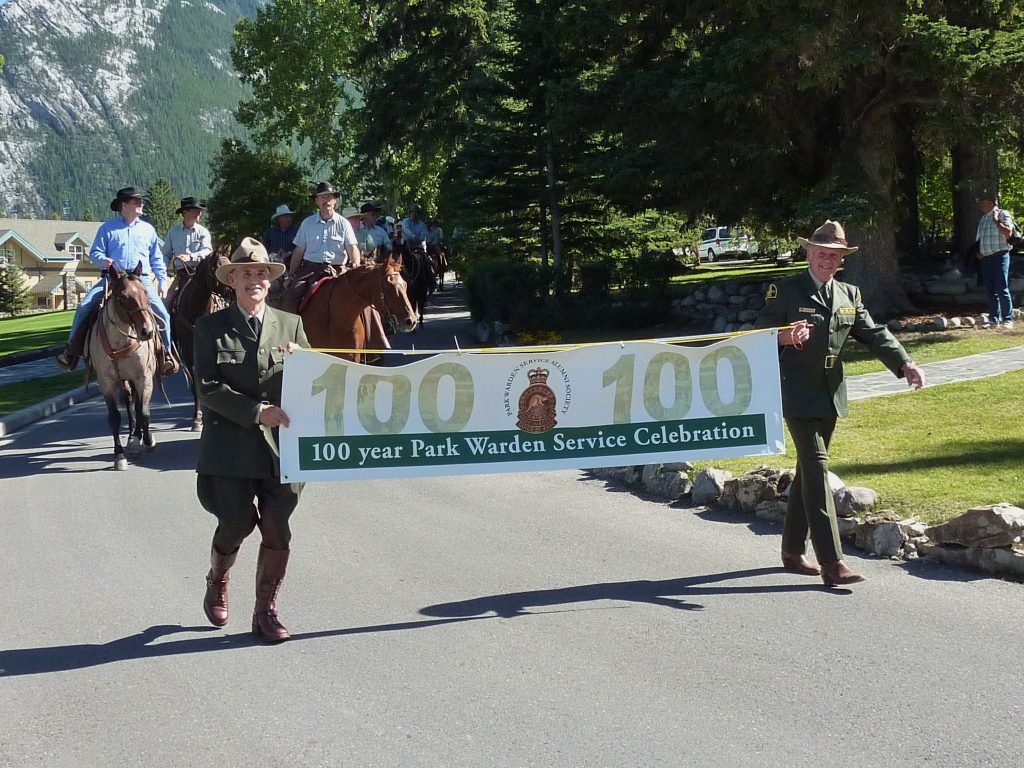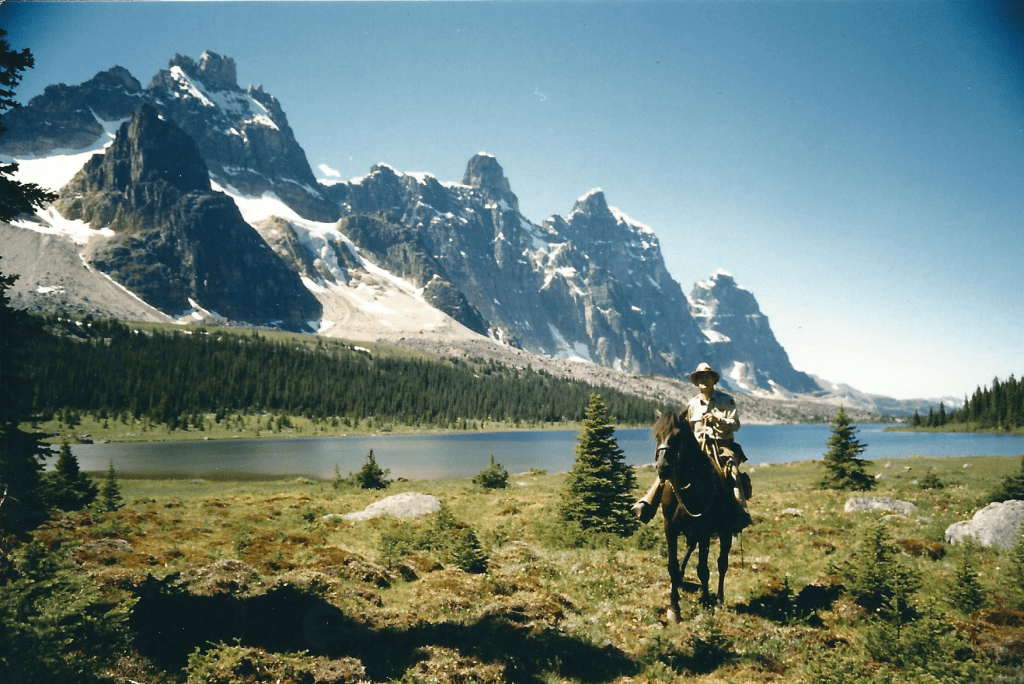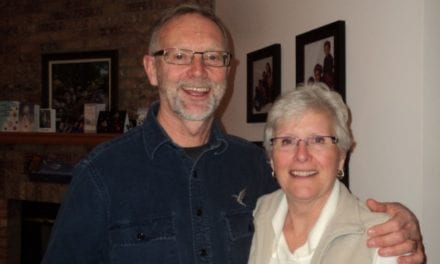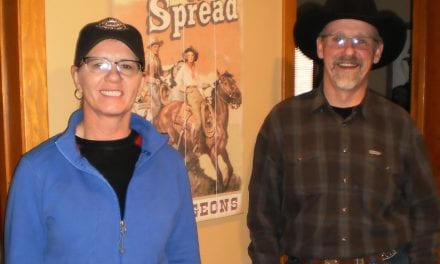Thank you to the Whyte Museum of the Canadian Rockies for granting permission to the Park Warden Service Alumni to post this interview on our website
Park Warden Alumni Society of Alberta
Oral History Project Fall 2018
Phone Interview with Bob Barker
December 3rd 2018@ 0930, MacKay, Alberta
Interviewed by Monique Hunkeler
Bob Barker served as a park warden in Jasper National Park for 35 years. He loved being the back-country warden in the Brazeau, but also worked the front-country. His career involved law enforcement, public safety and resource management. Bob grew up riding horses and at the get of 18 he went for work for various outfitters in Banff and Jasper where he learned to pack horses. Bob’s enthusiasm for the national parks continues far beyond his retirement.

Bob Barker and Bob Haney proudly carry the banner at t he 2009 Warden Service Centennial in Banff.
Place and date of birth? Bob was born March 27th 1941 in Cold Lake Alberta.
MH: Where did you grow up?
Bob: I grew up west of Bergen, southwest of Sundre, Alberta. I went to school in a country school, Red Deer Valley, 1.5 miles from home. And in Grade 6 we caught the bus to Sundre and finished school in Sundre.

Bob riding Flag, leading Molly May 1977.
MH: How did you become involved in the Warden Service? Which national park did you start working in? 0123.
Bob: I was working for outfitters throughout the mountains from Banff to Jasper and met a lot of wardens. I happened to be working at Lake Louise with the Regnier boys (Charley and Richard), Keith Foster, and Bob Haney in 1962 at Ray Legace’s pony stable. I’d been to Jasper in 1959-1961 then came back to Banff and worked for Bill Martin next to the Brewster Stables in Banff and then left there and went up to Lake Louise and got a job with Ray Legace and did packing and that with Charley and Richard Regnier. Went back to Jasper in 1963 and worked at the Jasper Park pony barns 1963.
In 1964; I went to work for Tom McCready, (Jasper) middle of July 1964-1965. Got all my packing training through the outfitting and 1965-1966 I left and went to work construction for Standard General on the highway from Jasper to Geike (8 miles of highway). Winter of 1967, I saw an ad for wardens and I’d met so many wardens over the time and thought boy what a nice life and I wouldn’t mind that. They kept coaxing me to apply so I put in on a competition and I was accepted. I went on an interview in Edmonton and the Chief Warden in Jasper was a good reason I got hired in the first place, Mickey McGuire. Anyway, I got this letter that said I had a seasonal position in Waterton if I wanted it. So I wrote them back and said I’d really like to take the job but I have year round employment and I didn’t want to leave what I had for a seasonal job. Around March I got another letter back saying to report to the Superintendent and the Chief Warden of Jasper National Park for year-round employment. So on April 3rd I reported in and got hired on. My first posting was at Pocahontas under Abe Loewen and also before I moved out there, I had my first mountain rescue off Roche a Perdrix on the east boundary of Jasper. I was on the follow up team to rescue this fellow. Also involved in my first bear mauling. (Roche a Perdrix was named in 1872 by Rev. George Grant. It is a mountain located south of Highway 16 on the eastern border of Jasper National Park, and is part of the Fiddle Range, one of the easternmost ranges of the Canadian Rockies. It lies directly on the park boundary. In French, Perdrix means ‘partridge’ and Roche means ‘rock’. The name is a reference to the rock foliations which resemble the tail feathers of a partridge.)
I spent the whole season there (Pocahontas) up until December. I pretty well worked Fiddle River. I was up there more than I was on the highway. Then I moved back into Jasper and did whatever came up. We had an elk slaughter that took place and I was involved with the rest of the fellows. And in 1968 I was asked to take over the Brazeau district in the southeast corner of the park in from the Icefields and I was stationed there for just over 4 years. Got Married in 1969 to Barb Young, her dad was a warden, and our oldest daughter Cheryl came along while we were in there. It was quite a life, there were a lot of outfitters in the area in the hunting season time and got involved in a few incidents, (like) poachings. Our second daughter Honya came along after we moved to Snaring River (district) in September 1972. Started working in Jasper; (my) whole career was in Jasper.
MH: What made you want to join the Warden Service? 0854:
Bob: Keith (Foster) and I were working real close together in Lake Louise, and Johnny Turnbull rode in one day headed for the lookout to take the food and supplies to the lookout fellow. He was in full dress uniform came riding in there and we both said boy this is the life. He was one of the first guys who really impressed me.
In 1964 and 1965, I got hired to operate the lifts on Whistler Ski hill. I operated the Poma Lift and rope tow…took it over thanks to Bill McKinnon. That’s where I really met the wardens because they were up there all the time training. Marmot (Basin) was just getting started. Tom McCready and Joe Cautuer were just getting things organized at Marmot. 1965 Marmot was just starting.
MH: What different parks did you work in? How did they compare? Do you have a favourite? 1135:
Bob: Jasper was the one and only park I worked in as a Warden. They bring up Banff all the time but Jasper is a lot flatter country and more open and it is good for horses. I really like Banff too; I travelled lots there before I was a warden in Jasper.
MH: What were some of your main responsibilities over the years? 1155:
Bob: Law enforcement was a heavy responsibility, helping with Public Safety, Resource Management, environment, fire control and stuff. Anything that came up, we were all trained to chip in where we were needed.
The Brazeau – I lived year round, 1968-72. I was one of the last wardens with a family in the bush. We moved from there to Snaring (River) (and lived there from) Sept 1972-75, north of Jasper about 16 miles and eventually they centralized everybody in the 1970s and we moved into town. In 1975 we moved into town when Cheryl was just starting school. Brian Wallace (Willow Creek) and Al Stendie (Blue Creek) were on the north boundary still a year after I was moved. They were the last ones to be moved into town.
MH: What did you like / Dislike about being a warden? 1410:
Bob: Every part of it! You woke up in the morning and you never knew what you would be doing. Every day was a new day and being in the backcountry, I spent 25 years backcountry. I would go back there tomorrow.
Dislike? – Mountain climbing. Any higher than my horse I got airsick. I told Willi Pfisterer, “Willi, you know I don’t really care to climb mountains but I want to learn everything about them.” So what I learned was what was going to be needed. Everybody doesn’t need to be on the mountain so they didn’t call me for a rescue other than to get supplies out to them. I’d like to learn everything that’s needed on a rescue out of the warden stores but as far as being up there, you’d be rescuing me. Didn’t like flying under the helicopter, preferred flying in the helicopter. There were guys that were made for that and I wasn’t one of them. I was a horse person.
MH: What were some of your more memorable events as a Warden? 1630:
Bob: A lot of my more memorable events were helping new people coming on. I really enjoyed the first 6 women who were hired. I did a lot of training of new people in the Tonquin Valley. It was easy access as it was only a four-hour ride from Cavell into Tonquin and you could spend ten days training somebody there. I found the women were a great asset to the warden service. Some of the first women were Kathy Calvert, Betty Beswick, Trish Tremblay, Jean Stoner, and Cyndi Smith – I really enjoyed her too, she was up at Blue Creek. Those were the ones that stuck out in my memory. They were trying to prove that women could do it and they had a tough task. They were really eager to learn. I tried to teach them things like when they had to remove a tree from the trail, to cut it into pieces they could move so as not to hurt themselves. They were a good bunch of girls. I enjoyed the girls my whole career.

Bob on Ranger by Moat Lake, Tonquin Valley
MH: Can you tell me about any rescue/wildlife stories that stick out in your memory? 1920:
Bob: Probably the first story that stood out was the first rescue on Roche a Perdrix which ended up not good, but it was an eye opener. I worked with a good bunch of fellows and had meetings afterwards to discuss how things could go better. Learned what was really involved because I was new and had no idea what they had to do. I knew it was a tough operation.
2020: I had a bear incident at Pocahontas that involved a young boy who got chased into one of the cabins by a young bear, grizzly. When the construction outfit was building the highway, the cook was feeding this sow and her cubs and he was later charged by the other wardens and it caused an incident at the bungalows. We ended up shooting the one cub. The other two cubs returned to the dump because they knew there was food. We went to the dump the one day, Norm Young and I, went to check on these bears to see if they were behaving themselves or not and one came up to the truck – when his face was close to the windshield, he seemed pretty big. Norm threw it in reverse and backed out of there. We thought we better leave them alone. A young bear can look pretty big when it’s only inches away from the windshield…it did a little tap dance on the hood of the truck. There were a number of bear incidents on the south side. Jim White was stationed at Mile 45 (or Sunwapta) and we had a number of people feeding bears, traffic jams like you wouldn’t believe. That was a regular routine thing throughout the career. There were lots of bears in town when I first moved there. It was all because of garbage and the carelessness of people. They cleaned it up.
Moving elk at different times from Jasper to Elk River and north. We corralled 150 head out of Jasper Park Lodge and the townsite in the 1980s. There were different things that came up with wildlife and all the aspects of the wildlife throughout the park, wardens were involved with. Whereas now not so much, it’s all individual specialists now.



